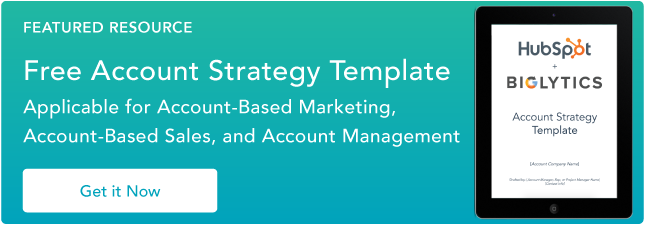Imagine the world of account-based marketing, where you start the sales process by selling directly to your best-fit, highest-value accounts.
 align="middle">
align="middle">
No wasted time trying to market to unqualified leads who aren’t the right fit for your business. You can move straight into the phases of engaging and delighting your target accounts. Talk about efficiency, right?
Account-based marketing allows you to weed out less valuable companies early on and makes sure that Marketing and Sales are in complete alignment. In return, your team can leap into the critical processes of engaging and delighting target accounts much faster.
What is account-based marketing?
Account-based marketing (ABM) is a strategic approach that focuses on high-value accounts in a market or business. ABM strategies focus on creating personalized buying experiences for better customer acquisition, relationship-building, and business growth.
ABM helps your business work and communicate with high-value accounts as if they’re individual markets. By doing this — along with personalizing the buyer’s journey and tailoring all communications, content, and campaigns to those specific accounts — you’ll see greater ROI and a boost in customer loyalty.
In this post, we’ll take a look at the benefits of account-based marketing and how to create an ABM strategy. But first, let’s review its relationship with another important strategy: inbound marketing.
Account-Based Marketing and Inbound Marketing
Batman and Robin. LeBron and D-Wade. Peanut butter and jelly. Arguably, some of the strongest partnerships ever to exist. These dynamic duos are forces to be reckoned with.
Similarly, when paired, account-based marketing and inbound marketing have the power to make waves (the good ones) for your business.
You might be wondering, “How exactly does this partnership work?”
Well, we just reviewed the definition of account-based marketing — as you learned, ABM is a highly targeted strategy.
Meanwhile, inbound marketing is more foundational — this methodology and growth strategy allows you to attract customers through the creation of valuable content, SEO, and a delightful customer experience.
Rather than interrupting your target audience and customers (as you would with outbound marketing), inbound marketing allows you to give your audience the information they want when they want it.
Inbound lays the foundation for a strong ABM strategy by allowing for highly targeted and efficient resource allocation of high-value accounts. Here are a few more reasons to employ both ABM and inbound marketing strategies at your company:
- Inbound marketing helps you attract target accounts and then ABM accelerates the flywheel so you can win and delight those accounts with a remarkable customer experience.
- Inbound marketing lays the foundation for a strong ABM strategy — ABM builds off of inbound by allowing for targeted and efficient resource allocation of high-value accounts.
- With this combined approach, you attract a broader group of prospects than you would while using just one method.
- Your content has a two-for-one value — you can create and use content that serves both an ABM and inbound strategy (such as adding a personalized case study for a target account that you also share on your website).
- Software — such as HubSpot’s account-based marketing tool — exists to make it easy to implement ABM and inbound strategies in a complementary way.
TL;DR: Combine ABM and inbound marketing to grow better.
Benefits of Account-Based Marketing
- Keep Marketing and Sales aligned.
- Maximize your business’s relevance among high-value accounts.
- Deliver consistent customer experiences.
- Measure your return on investment.
- Streamline the sales cycle.
- Expand business through account relationships.
There are many benefits associated with account-based marketing. We’ve compiled this list of results that positively impact all types of businesses.
1. Keeps marketing and sales aligned.
Cross-team collaboration and improved communication across any organization are beneficial to growth.
In account-based marketing, this transparency and alignment will confirm that your marketing and sales teams are focused on the same goals, stick to the mutually agreed-upon budget, and understand the specific roles of each internal stakeholder.
This alignment helps make sure all communications, interactions, and content are consistent for the accounts you work with.
Meaning, no matter how long an account works with your company, your team members can pick up where others left off at any point without question — this creates a seamless and delightful customer experience.
🧡 The easiest way to support internal account-based marketing alignment is with the help of software, like HubSpot, which makes connecting your marketing and sales teams exceptionally easy.
2. Maximizes your business’s relevance among high-value accounts.
Account-based marketing requires you to personalize everything (such as content, product information, communications, and campaigns) for each account you invest your resources in.
Through this personalization and customization, your relevance among these accounts is maximized.
That’s because your content and interactions are tailored in a way that shows them how your specific products, services, and other offerings are what they need to solve their challenges.
Meaning, ABM allows you to angle your business in a way that makes it the most relevant and ideal choice for your target accounts.
3. Delivers consistent customer experiences.
For your ABM strategy to be remarkable, you must create a long-term sense of delight among your accounts. Each account should feel as though they’re your business’s market of one. Tackle this by offering consistent customer experiences.
ABM is a strategy that requires major alignment between Sales and Marketing — so home in on that when working to deliver those consistent experiences.
Confirm all team members are aware of where an account is in the buyer’s journey — then, deliver personalized and prompt communication, campaigns, product information, and pricing details.
4. Measures your return on investment.
With account-based marketing, you can easily measure return on investment (ROI) for each account you invest your resources and time in.
This is beneficial because you can confirm whether certain accounts you invested in were ideal for your business.
Then, you can nurture and delight those accounts long-term to keep them, as well as recognize and target similar accounts in the future. If your ROI proves the ABM tactics you used worked, use that data to propel your strategy forward.
5. Streamlines the sales cycle.
Depending on your business, industry, and resources, the sales cycle typically looks something like this:
1) Prospect → 2) Connect → 3) Research → 4) Present → 5) Close → 6) Delight
With account-based marketing, this cycle is streamlined — by focusing your efforts on specific high-value target accounts, you save time and resources.
This means you’ll have more time to focus on the stages of the cycle that positively impact your bottom line:
1) Identify Target Accounts → 2) Present to Target Accounts → 3) Close Target Accounts → 4) Delight Accounts
ABM streamlines your sales cycle by helping you stay efficient.
Rather than experimenting with different tactics to prospect and qualify a large pool of leads, ABM confirms the accounts you target are the right ones for your business and vice versa.
The sales cycle is also streamlined by your marketing and sales alignment as well as the consistent and personalized customer experiences you offer.
6. Expands your business through account relationships.
The saying “quality over quantity” applies to account-based marketing.
The process requires you to invest significant time and resources in engaging and delighting a group of carefully chosen, high-value accounts.
This is instead of trying to quickly close deals with less-qualified leads who may not be the best fit for your company in the long run.
By taking the time to build these trusting relationships with accounts, you’ll expand business by keeping those valuable customers longer.
And considering it costs more to obtain customers than retain them, this will positively impact your bottom line.
Additionally, as a result of personalized, thoughtful, and consistent customer experiences, accounts will become loyal to your business over time — and loyal customers become your best marketers, promoters, and brand advocates.
In other words, your accounts will help you expand your business among their networks (for example, partners or customers) through referrals, word-of-mouth marketing, testimonials, and more.
To get started, let’s cover the framework for account-based marketing.
Account-Based Marketing Framework
ABM works differently from a traditional sales funnel. Though ABM can be put in place across different industries and types of businesses, a general framework needs to be followed to guarantee its effectiveness.
Here are the key parts of an account-based marketing framework.
Marketing-Sales Alignment
The working relationship between sales and marketing organizations is mentioned several times throughout this article, because its importance can’t be overstated.
To have a comprehensive approach to ABM, and to make sure target accounts receive an engaging buying experience, marketing and sales have to be on the same page.
When trying ABM, sales and marketing organizations will need to agree on:
- Resource allocation for each target account
- Roles and responsibilities to create a seamless transition for the customer between marketing and sales activities
- How to measure the success of ABM efforts
Account Qualification
How does your company decide what a high-value account is?
Creating an ideal customer profile for the accounts your company wants to target is key to answering this question and creating an ABM framework.
It’s also worth noting both marketing and sales should be participating in these conversations.
As you figure out what qualifies a potential account, consider these factors:
- Financials: With your company’s sales goals in mind, consider how much revenue can be generated from an account.
- Scalability: Based on what you know about the potential account’s business performance, is there potential to grow the account in the future? Consider extra offerings your company could provide to retain and grow the account.
- Competitive Landscape: Who are your competitors selling to? Understanding who is in the market for products and offerings like yours can help you figure out future account opportunities.
Go-to-Market Approach
Once marketing and sales are aligned on approach and which accounts to target, it’s time to map out a go-to-market plan.
Understand exactly how a new customer would move through the sales process using an ABM approach.
While preparing to go to market, you may find areas of friction that need to be addressed or areas of poor communication that can be strengthened.
Because a personalized experience is so important in account-based marketing, your team will want to be on the lookout for extra ways to add value and deliver a premium experience to these accounts.
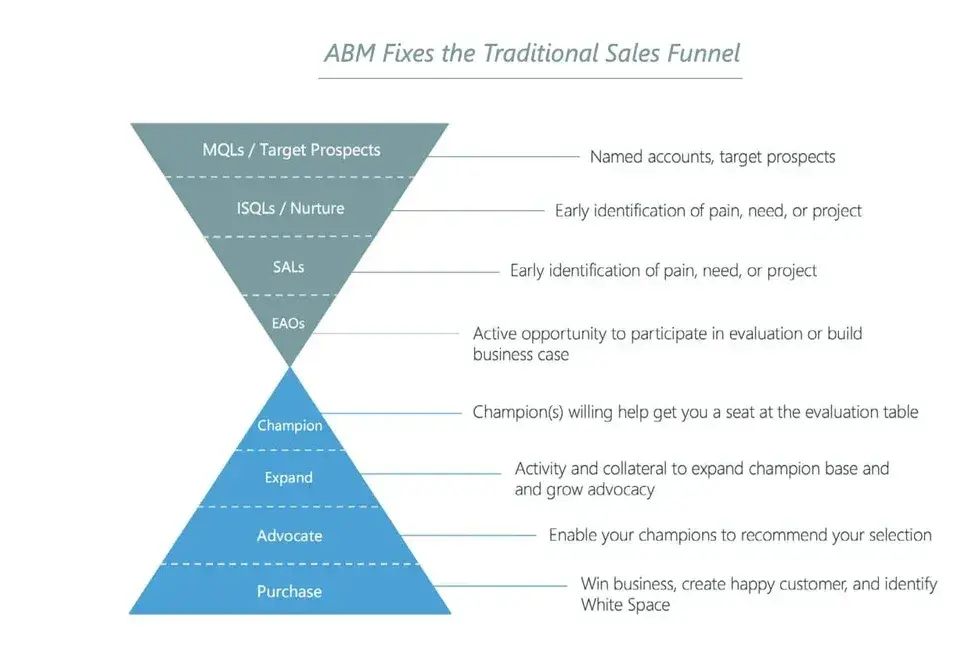
Account-Based Marketing Strategy
To get the most out of an account-based marketing approach, you’ll need a sound strategy in place. Consider following these steps to create an effective account-based marketing strategy.
1. Use a strategic account planning template.
To unify your account-based marketing team, use a strategic account planning template. The free template will help you outline your initiatives for each unique account, such as the following sections:
- Business overview.
- Key business initiatives.
- Customer relationship landscape.
- Customer products and revenue.
- Account competitor analysis.
- Buying process and selling points.
- Relationship goals and strategy.
- Sales opportunities, targets, and risks.
- Action plan.

Download the Free Account-Based Marketing Plan Template
2. Secure organizational ABM alignment.
One of the most important account-based marketing tactics is pretty straightforward — getting alignment.
This means getting all internal stakeholders on board with your account-based marketing strategy.
This will make it easier for your business to create consistent experiences for accounts. It will also make sure your strategy is as efficient and streamlined as possible.
Marketing-sales alignment is crucial. To create a custom buying experience, a customer will need to have a seamless transition from becoming a lead through the final sale.
For example, your VPs of Marketing and Sales should secure organizational alignment. This will help spread awareness for:
- Marketing and sales team members who are directly involved in the strategy.
- Account-buying committee members and any other account stakeholders.
- Your business’s point-of-difference for each target account.
- ABM budget and resources.
- ABM goals and KPIs.
Both teams must commit to clear communication and find a middle ground. This will help you make sure that the marketing team is acquiring qualified leads for the sales team.
Besides marketing and sales, don’t forget to choose other internal key players — such as customer success reps — who should be aware of and aligned on your ABM strategy.
3. Build your ABM team.
Marketing and sales leaders will want to align on how to build your ABM team.
If you’re just getting started with ABM, try creating a small task force with one marketer and one salesperson. They can work together to find potential issues and generate ideas before focusing on executing your ABM strategy.
As your efforts scale, this marketer could support more salespeople. On average, one marketer can typically stay aligned with up to 10 salespeople, and each salesperson can manage up to 10 accounts.
A minimum of one marketer and one sales rep should be completely dedicated to the accounts you work with at all times.
These people will create and publish content for accounts. They’ll also work to manage and close business deals with each account’s buying committee.
4. Research and pick your ideal set of target accounts.
Once you‘ve selected your team and aligned on the approach, it’s time for your company to target the correct accounts and personas.
This usually begins with a period of research to figure out which accounts to pursue. When creating customer personas for an account-based marketing approach, marketers should consider:
- The mission, vision, and business objectives of their ideal customer.
- If any high-value accounts are already engaging with your company’s Inbound approach.
- The current stage of business maturity, company size, and growth trajectory.
- Revenue model and spending patterns.
- The tools and platforms their ideal customer is using.
Next, review your findings and pick your ideal set of high-value target accounts to invest your time and resources in.
There are countless ways to choose key accounts. Here are some recommendations on how to get started:
- Set search alerts for your ideal customer profile on LinkedIn.
- Create a workflow that filters incoming qualified leads based on specific criteria (such as company size or industry) and tags them as an ideal customer type in your CRM.
- Ask, “If we could replicate one deal from last year, what would it be?” Then, use the characteristics of that deal (such as industry, company size, value) to help you find other good-fit customers.
- Pick target accounts based on a particular industry or geographical location.
- Review major companies and leads who are using and engaging with your inbound content but don’t have a deal attached (yet!).
- Find the lighthouse accounts you could use for reference.
- In this stage of the process, what’s most important is that marketing and sales agree on which accounts to target.
According to HubSpot Academy professor Kyle Jepson, “If your marketer is targeting one list of companies, and your salespeople are working a different list, you’re going to end up with an account-based mess.”
Check out this post to learn more about choosing the right AMB accounts.
5. Finalize account plans.
After deciding which accounts to target, it’s time to build account plans. In this step, your marketing and sales teams will work together to map out:
- Potential leads they’ll need to attract to reach their target accounts
- What content they need to produce to engage with this audience
Account-based marketing is a team effort.
Each account plan should be able to answer two important questions:
- Who makes the buying decision for this sale?
- What content do you need for each member of this buying committee?
So, make sure Marketing and Sales ask the following questions while they work on account plans:
- Who will we need to know at each account? Who are the buying committee members, decision-makers, influencers, blockers, end-users, and account stakeholders?
- What content will we need to attract and engage account-buying committee members (and any other stakeholders)?
- Which channels will we use to share content with the right people at each account?
- How will we (marketers and sales reps) offer the right type of support throughout each stage of the strategy and sales process?
- How will sales help at the outset and how will marketing support in the later stages?
Note: Store your account plans as pinned notes in your HubSpot CRM, Google Docs, Asana Boards, pinned messages in Slack, and more to allow for easy access and collaboration.
Here are a few other tips and best practices you can use to make your ABM plans successful:
- Connect your different sales and marketing applications to make sure all your ABM apps are aligned.
- Make sure Marketing and Sales align on your product or service’s value proposition for every account.
- Use a marketing plan template to make sure your plan includes the details your plan needs to be effective.
- Customize each plan to the needs of that particular account.
- Create personalized content — or update existing content — so it’s tailored to each unique account.
- Customize your allocated resources and budget for each account.
6. Attract contacts associated with high-quality target accounts.
Next, you’ll want to attract the buying committee members and stakeholders of your target accounts.
Depending on how long you’ve been in business and any previous ABM work you’ve done, you may or may not already have contacts for specific accounts.
Ideally, using Inbound methodology will help you attract contacts associated with your target accounts.
If you need more contacts, your next step is to figure out where your ideal contacts are going to find solutions related to what you offer. Then, make sure your company is visible and represented in these spaces.
The key to successfully attracting high-quality accounts is to personalize content to those accounts. This will help you elevate brand awareness and maximize relevance among audience members.
It can be tempting to try to get visibility for your company through all available avenues. But you’ll get the best results through the channels that are most relevant to your target accounts and contacts.
Here are some GDPR-compliant recommendations for attracting high-quality accounts:
- Ask current contacts, accounts, and customers for referrals.
- Engage accounts on social media. Figure out which platforms they’re on, join the groups they’re in, contribute to conversations they’re a part of, and share helpful and relevant content you’ve created.
- Send direct messages through social media, email, or post.
- LinkedIn is a popular platform for businesses. Communicate through LinkedIn InMail outreach without ever leaving HubSpot with the LinkedIn integration.
- Produce a podcast or video series and invite a leader from the account to be a special guest.
- Sponsor a booth at a target account’s conference or event.
- Share industry content, such as blog articles or newsletters, across channels that are relevant to each account. Use your website, social media, and magazines — and make sure that your messaging is where your target customers are.
- Invite contacts to (physical or digital) events and ask attendees to invite their colleagues.
- Build custom landing pages tailored to the needs, questions, and concerns of accounts.
- Offer gifts for engagement and interaction (such as prizes, swag, and discount codes).
- Create targeted ad campaigns to target different factors such as location, skill, and job title.
7. Forge strong relationships with the account’s buying committee.
Once you’ve attracted high-value accounts, it’s time to forge strong relationships with their buying committees.
This is something your team will likely work on over an extended period of time. Keep in mind, it often takes months and even years to develop these bonds.
Your primary goal is delighting your accounts — and you can never stop the process of delight.
Try tools like Enlyft that give you insight into details such as recent funding dates and technologies prospects are using to help you better understand and solve the problems your prospects face.
Here are some thoughts on how you can forge strong, long-lasting relationships with an account’s buying committee.
- Offer education around the value of your business — and your product/ service.
- Create and share personalized content like case studies to show how you’ll exceed expectations and resolve challenges.
- Communicate one-on-one when possible to make buying committee members feel like they’re your only priority.
- Host events with and for account members (such as dinners, lunches, or social meetups) so they get to know your brand and team on a personal level.
- Stick to organized, well-timed meetings.
- Use email sequencing to enhance all communication, be professional, and stay consistent.
HubSpot’s ABM Software Target Accounts Home and Account Overview features will help you forge strong relationships.
As you build relationships with key contacts, make sure both sales and marketing are actively engaging everyone involved in buying decisions.
Though this stage is typically led by sales, marketing should be ready to support. Be sure to develop useful materials to reinforce messaging.
Learn how to showcase your company’s success using compelling case studies with a free case study creation kit.
8. Measure and analyze your ABM results (and iterate as needed).
Once you’ve put your account-based marketing strategy in place, it’s crucial to track the success of your tactics.
So, review and analyze your ABM results to find any gaps or tactics that you want to update. This will allow you to make your strategy more effective for your business, marketing and sales teams, and accounts.
To measure the health of an ABM strategy, marketing and sales teams can use the following metrics:
- Find the buyers associated with target accounts and track interactions with these buyers.
- Data points related to the health of the deal—creation date, velocity, and close rate.
- Revenue attributed to target accounts.
- Account penetration (net new contacts added to an account)
- Account engagement
- Net-new revenue
For support with your analysis, enlist the help of HubSpot’s library of 12+ ABM reports and pre-built ABM reporting dashboard to gain valuable insight into how to modify your ABM strategy for greater success.
Refining your ABM strategy makes it easy for your marketing and sales teams to repeatedly attract and retain high-value customers. You can also automate your ABM strategy to quickly scale your winning results.
Account-Based Marketing Tactics
ABM tactics are the building blocks of your strategy. As you’ve already learned, customization is key. So, review the following tactics and decide which approaches will work best for each of your target accounts.
Tailored Value Proposition
Top-of-funnel marketing strategies are broad and brand-focused. But, account-based marketing needs a value proposition that’s specific to each account.
So, craft a compelling value proposition that addresses the unique challenges and goals of each target account.
This message should clearly articulate the value your product or service brings to the organization and its impact on their specific pain points.
To create each value proposition, make sure you understand the detailed pain points, needs, and goals of each account.
Be sure to highlight how your product or service addresses those specific challenges. This can help you avoid generic messaging while staying consistent with your brand.
Try these value proposition templates to create useful and targeted value propositions for each of your target ABM accounts.
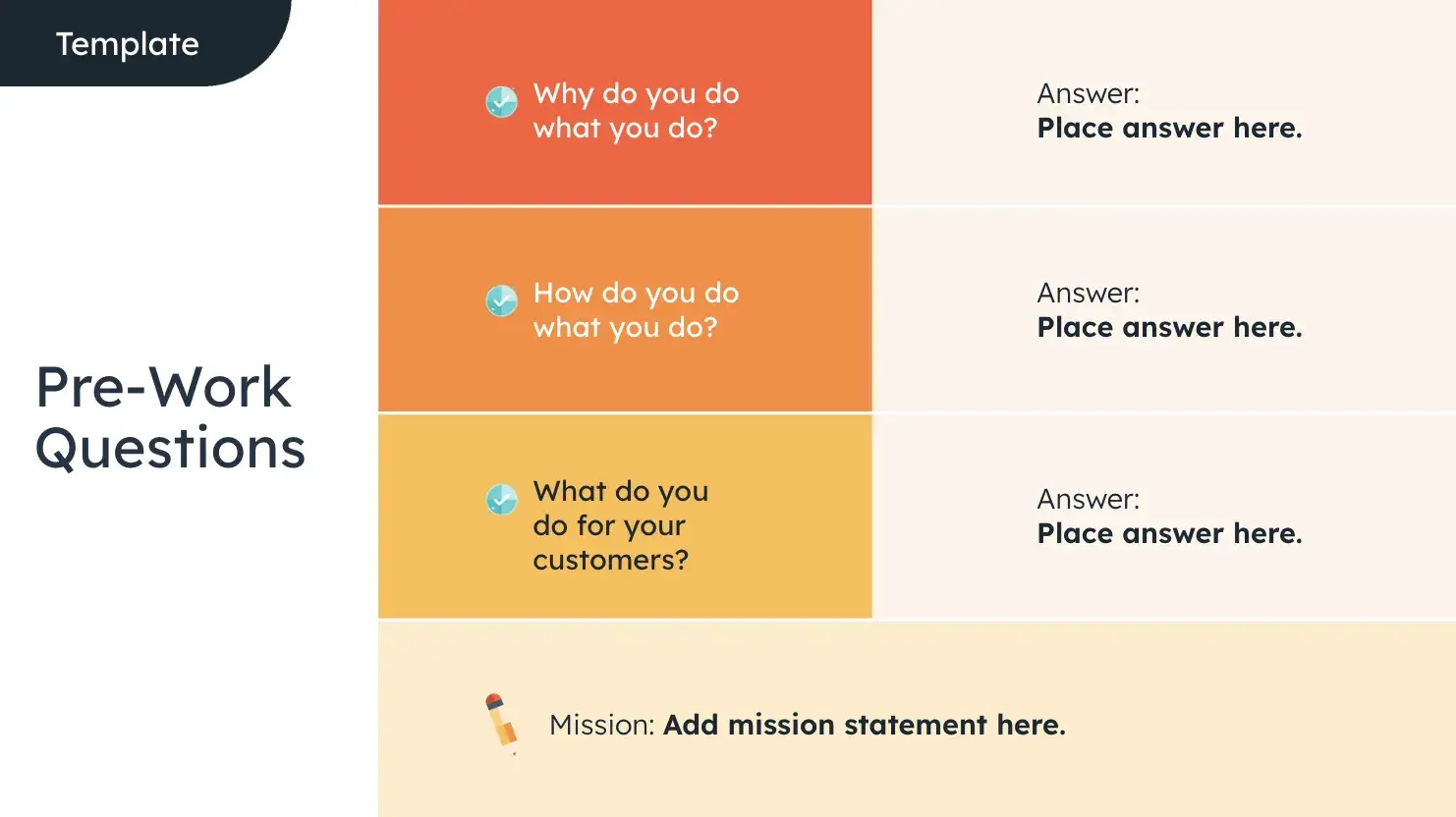
Download the Free Value Proposition Templates
Stakeholder Mapping and Engagement
Once you know who the key stakeholders are within each target account, map their roles, responsibilities, and influence.
This deep dive into your stakeholders can help you develop relevant communication strategies. This level of personalization can help you engage and build relationships with these decision-makers.
If you’re not sure how to figure out all stakeholders or map specific roles, start with communication tracking. Keeping track of every interaction can help you better understand stakeholder relationships.
Lead management and email tracking software can make it easier to connect these conversations.
Web Personalization
Connect with accounts online with customized website experiences.
For example, you can use a free landing page builder to create landing pages for each target account. Personalize landing pages for each account, adding relevant content, like case studies, and calls-to-action that engage decision-makers.
To create quality landing pages, it‘s important to collect accurate data. That said, make sure content isn’t so personal that it feels overwhelming. These tips on website personalization can help you find the right balance.
Account-Based Social Selling
Encourage your sales team to use social media platforms to engage and build relationships with target accounts.
Platforms like LinkedIn make it simple to share personalized content, add to relevant discussions, and network with key stakeholders.
Attention to detail is important with this ABM tactic. First, you need to choose platforms where your target accounts are active and engaged. Next, you want outreach to feel authentic.
If you have a hard time reaching out on social media, these discovery call questions are great inspiration.
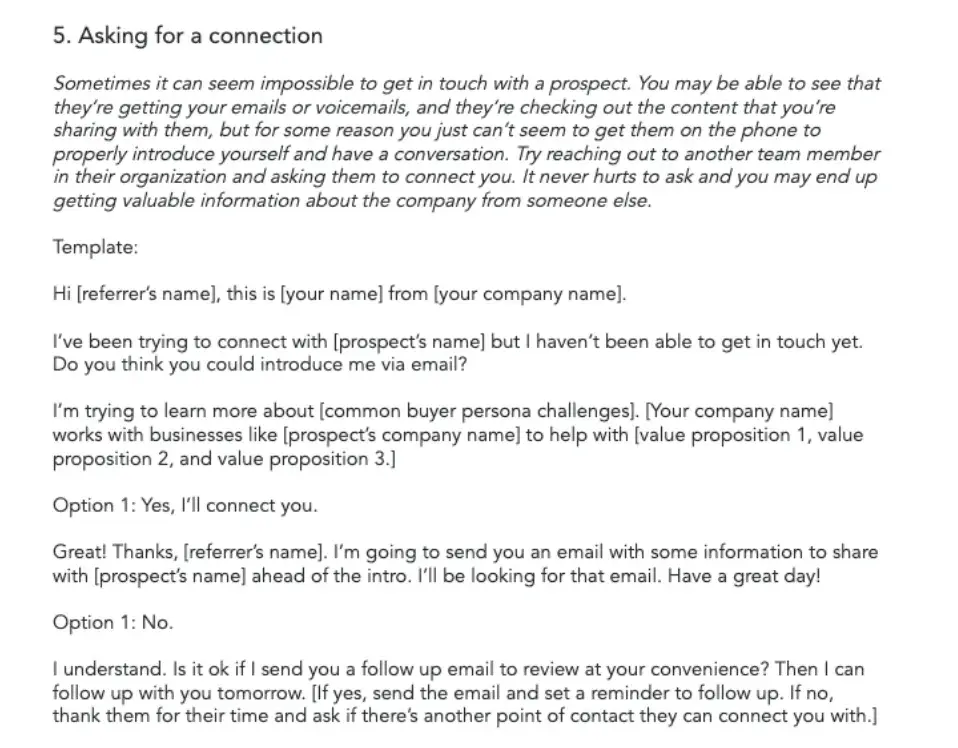
Download Sales Call Templates for Outreach
Paid Advertising
Advertising platforms can help you deliver personalized ads to key individuals in your target accounts. This can help increase brand awareness and engagement while staying top of mind.
For this tactic to be effective, be sure to tailor ad messaging to specific pain points and goals. This guide to ABM advertising can help you refine your tactics too.
Retargeting
Retargeting is useful for converting stakeholders who have already shown interest in your offer. Retargeting can help you optimize your ads with relevant content across channels.
This can help you further target account decision-makers to take desired actions, such as visiting a website again or downloading a resource. It also reinforces your value proposition and maintains brand visibility.
Events and Experiences
Host targeted events, webinars, or roundtable discussions just for your key accounts. You can customize the content, agenda, and attendee list to address the specific pain points and objectives of each account.
For this tactic to be effective, your events need to add value. Offer unique experiences, networking opportunities, and valuable content that align with the interests and needs of target accounts.
Post-event, be sure to follow up and continue relationship building.
Targeted Content
Targeted content is more than phone calls, personalized emails, and social media interactions.
Create an outreach cadence that combines multiple touchpoints and channels. Maintain a consistent presence to nurture relationships and keep your brand top-of-mind.
Create high-quality targeted content assets, such as blog posts, industry reports, case studies, or videos, that speak directly to each account’s pain points, industry trends, and desired outcomes.
Then, make sure that the right content is reaching the right stakeholders in your target accounts.

Download Content Marketing Planning Templates
Account-Based Marketing Tools
As you’re moving target accounts through the sales process, choose the right tools to streamline ABM efforts.
When looking for account-based marketing software, make sure your platform makes selling easy. Look for:
- Identification: Accurately find potential customers and accounts with templates and AI-powered features.
- Enables collaboration: Shared tools to help your company keep conversations between teams and potential customers going.
- Analytics: You’ll need access to relevant data to understand how well your approach is performing.
ABM integrations are also essential. For example, RollWorks is an ABM automation tool that seamlessly integrates with your CRM. (If you’re a HubSpot customer, take a look at the RollWorks and HubSpot integration.)
ABM automation allows your business to target key customers with a customized approach to seamlessly move them through the sales process. Account-based marketing training can also give your team an edge.
Check out this post if you want to learn more about ABM software.
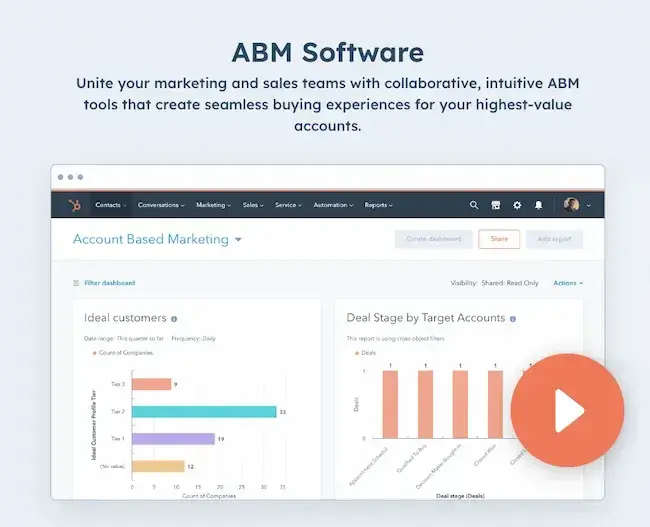
Account-Based Marketing Examples
Now that you understand the fundamentals of an account-based marketing strategy, let’s walk through a few examples of how ABM has worked for real businesses.
1. Restaurant Furniture Plus
This wholesale restaurant furniture supplier relied on search traffic and paid Google ads to attract new customers.
But after identifying its ideal customer (scaling chain restaurants), the company employed an account-based marketing strategy to get in front of restaurant owners who were a good fit for its products.
This strategy has helped Restaurant Furniture Plus save money on paid advertising, and increase its base of recurring customers.
2. HealthLink Dimensions
Healthcare data company HealthLink Dimensions partnered with marketing agency Acclaro to create an account-based marketing strategy.
HeathLink Dimensions sought to expand their offerings to health insurance providers and ran into challenges getting new contacts in its funnel.
After working with Acclaro to use an ABM strategy, HealthLink Dimensions experienced a 234% increase in its new customer pipeline.
3. BlueYonder
BlueYonder is a supply chain management company that helps businesses optimize their supplier activities.
In 2019, the company began testing an ABM approach with a small group of accounts. This initial test leveraged advertising and personalized content for the initial group of accounts and resulted in $10 million generated in pipeline.
B2B Account-Based Marketing
B2C companies typically focus their marketing efforts on touching a pain point or desire of the end-user, with hopes that the individual will decide to buy. B2B works a little differently.
When selling to other businesses, there is rarely one person making a purchasing decision. Depending on the size of the company you’re selling to, there may be an entire group of people who all give input on the final buying decision.
An ABM strategy can be particularly helpful for B2B companies who are looking to build long-term relationships with key accounts.
In fact, 72% of B2B marketers who used ABM in 2021 reported an increased ROI compared to other forms of marketing.
LinkedIn Account-Based Marketing
According to the 2023 State of Marketing Report, 33% of marketers said their company uses LinkedIn to connect. LinkedIn can be a beneficial platform for targeting accounts, especially for B2B companies.
LinkedIn has a feature called Company Targeting that allows you to use LinkedIn’s directory of over 13 million company pages for your ABM efforts.
With this tool, you can upload a list of companies you’d like to reach, and create ad campaigns that can specifically target individuals at these companies.
Additionally, LinkedIn can help you create a more personalized experience for your target accounts through genuine relationship-building with your buying committee.
Using LinkedIn to find and engage with the right decision-makers at the companies you’d like to work with can be a helpful, thoughtful alternative to using third-party data to find potential contacts.
Here’s how Adobe used LinkedIn to support account-based marketing efforts.
Grow Better With Account-Based Marketing
Account-based marketing doesn’t have to be overwhelming.
By working through the tactics we’ve listed above and using software for your marketing and sales team to use together, you’ll find valuable accounts more efficiently, reduce any friction impacting your flywheel, and grow better.
Editor’s note: This post was originally published in March 2022 and has been updated for comprehensiveness.


